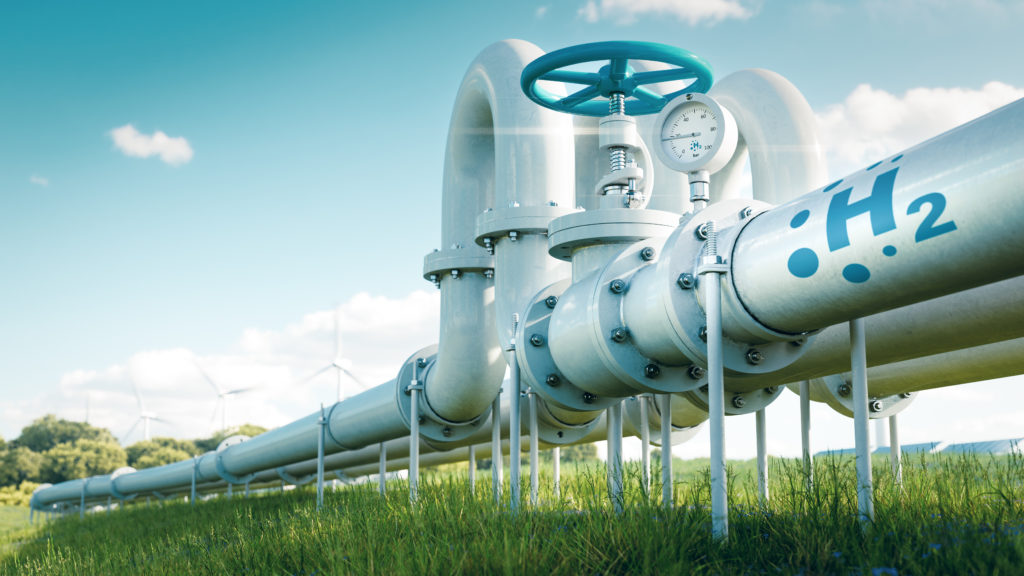Words by Paul Willis
Earlier this year Airbus signed an agreement with SEA, the company that manages Milano Linate and Milano Malpensa airports to study how the airports could be developed to accommodate Airbus’ hydrogen powered aircraft, which are set to go into operation by the mid-2030s.
More recently in November, Airbus made a similar agreement with three Japanese airports owned by VINCI. At the same time as this deal, the airport group signed agreements with several energy companies to integrate decarbonized hydrogen into operations at VINCI-owned Santiago Airport in Chile.
Also in November, the hydrogen startup ZeroAvia announced it had done a deal with the AGS airport group in the UK to explore the development of hydrogen fuel infrastructure. The agreement covers working out regulatory requirements and resourcing required for delivering zero-emission flights from Aberdeen and Glasgow airports.
This came on the back of an earlier deal this summer for ZeroAvia with Edmonton Airport in Canada, and a deal in late 2021 with London City and Rotterdam-The Hague airports. ZeroAvia hopes to see commercial hydrogen-electric flights between London and Rotterdam up and running in 2024.
But while the deals mentioned above might be grabbing headlines, smaller general aviation airports look likely to be among the first adopters of hydrogen-fueled flight. This is because the first hydrogen fuel cell aircraft are likely to be small jets used for short haul operations, says Chris Pickard, transport sustainability specialist for the global engineering company Jacobs.
“Some of these general aviation and business airports, particularly for their shorter flights, fit well as a good first use case for hydrogen,” says Pickard, who helped compile a recent Jacobs report entitled “Airports as Catalysts for Decarbonisation”. The report looks at the likely infrastructure required to transition airports to hydrogen-fueled flight.
Hydrogen from the highway

As a fuel hydrogen comes in two forms – liquid and gas. Hydrogen gas is already used as a fuel in the automotive industry which makes it a much better candidate for early adoption, says Dominic Weeks, head of marketing at ZeroAvia.
“It’s prevalent in road transport already and the technologies are available today,” says Weeks. “So we are able to optimize this for aviation and can get something certified and in market by 2025.”
The disadvantage of gaseous hydrogen compared to liquid hydrogen is the extra weight penalty. Heavy storage tanks are required to compress the gas which means that only a limited amount can be stored on-board before an aircraft becomes too heavy to get airborne.
These limitations mean that, similarly to battery-powered systems, gaseous hydrogen is only being looked at for shorter haul routes. ZeroAvia plans to use gaseous hydrogen in its first wave of hydrogen-powered flight, including for planned roll-outs at Glasgow, London City and Rotterdam-The Hague.
In preparation it has been conducting a full-scale trial of the infrastructure and technologies required at Cotswold Airport in the UK. As part of the trial ZeroAvia has been testing the efficacy of its Hydrogen Airport Refuelling Ecosystem (HARE), a fully integrated system that allows for the production and storage of hydrogen gas on-site.
Hydrogen gas is generated with an electrolyzer, a system that uses electricity to break water into hydrogen and oxygen in a process called electrolysis. ZeroAvia’s electrolyzer at Kemble makes about 10kg of hydrogen a day, which can be used for testing its hydrogen-electric powertrain, says Weeks.
“It’s a small-scale demonstration, but what it’s showing is the opportunity to decarbonize and remove pollution from not just aircraft propulsion, but from a range of different airport operations,” says Weeks.
The ongoing trial of its HARE system has revealed some of the challenges of working with hydrogen as an airport fuel, says Peter Gallen, ZeroAvia’s global head of commercial infrastructure. Chief among these challenges is the high electricity costs associated with electrolysis, he says.
“We’re doing a lot of work on the techno-economics of it because 80% of the cost of electrolytic hydrogen is electricity,” says Gallen. Another challenge Gallen and his team have come up against is the availability of key components for the process such as electrolyzers and compressors.
“There is a lot of investment going into hydrogen and trying to get your hands on electrolyzers is challenging because the supply chain hasn’t yet caught up with the demand that’s coming,” says Gallen.
Developing infrastructure

ZeroAvia isn’t the only hydrogen aircraft startup that has begun developing infrastructure for airports. California-based Universal Hydrogen recently signed a deal with UK, Channel Islands-based regional airline Blue Islands and Jersey Airport to supply its hydrogen fuel conversion kits. Universal will switch five ATR 72 aircraft in Blue Islands’ fleet to fly using hydrogen. The company will supply the hydrogen using capsules that will be transported from green hydrogen production sites to the airport and loaded into the aircraft.
According to Robin MacRae, airport director at Ports of Jersey, the company which operates Jersey Airport, the use of the modular capsule solution “requires minimal changes to airport infrastructure” with loading and unloading of the fuel pods done with “conventional equipment for the associated logistics”.
“The Blue Islands fleet is made up of ATR regional aircraft and includes an airframes that Universal Hydrogen is converting. Almost 98% of our electricity on island is already carbon-free because it’s sourced from nuclear and hydro-generation in France,” says MacRae.
While gaseous hydrogen will be the fuel solution for hydrogen-powered flight in the short-term, most experts agree that longer-term it will give way to liquid hydrogen. “Once the bigger jets come along the larger demand will be for liquid hydrogen. I’m sure that will be true for the whole market,” says Gallen.
Liquid hydrogen has two main advantages over gaseous hydrogen – a far reduced weight penalty, since it doesn’t need to be pressurized and better energy performance. It is widely regarded as the only currently viable zero-emission alternative to kerosene for long-haul air travel.
The disadvantage of liquid hydrogen is that it is cryogenic and only becomes a liquid at very low temperatures. This creates challenges, particularly for its storage at an airport, says Ian Sutherland, senior project manager for energy transition and hydrogen at Jacobs. Highly specialized tanks are required to ensure the fuel retains its cryogenic temperature. “It’s a tank within a tank, with a vacuum between them,” says Sutherland.
However, he notes that while the technology is specialized it’s already used in the space industry, where it has been deployed for many years for rocket propulsion.
Sutherland says, “It’s not something that you’ve got to go out and develop. Liquid hydrogen storage already takes place all over the world.”
However, the extremely low temperature of liquid hydrogen will mean airports will have to adhere to special handling requirements. “You have to very careful when you’re handling a cryogenic liquid because it can be extremely dangerous if human beings come into contact with it,” says Sutherland.
“Having said that, the protocols for handling liquid hydrogen are very well established.”
According to Pickard, the biggest challenge when handling a cryogenic liquid in an airport setting will be during the refueling process. He says, “For the upstream storage of liquid hydrogen it’s all existing processes and technology, but the process of transferring it to an aircraft in a live operational environment is something that needs more work.”
The type of infrastructure that airports would require to accommodate liquid hydrogen refueling will depend on how the airport chooses to source the fuel. The recent Jacobs report highlighted three potential scenarios for how airports could do this.
The first, and lowest-threshold scenario would involve transporting liquid hydrogen to the airport by truck. The second would involve building a pipeline to transport gaseous hydrogen to the airport that would then be liquefied on-site. The third would involve the production of hydrogen on-site through electrolysis.
Of the three scenarios, the first is probably the best-suited for business and general aviation airports, says Pickard.
“When we look at these different scenarios, there’s a phasing of how they might work over time for different airport sizes,” he says. “But for smaller airports, the first scenario is the starting point and probably the end point.”
This first scenario would require little extra infrastructure besides on-site storage tanks. By contrast, the second scenario would require the development of a gas pipeline and an on-site liquefaction plant.
The liquefaction plant would require “a reasonably large section” of an airport’s real estate, says Sutherland. “It’s a complex process since you’re taking something that’s room temperature and you’ve got to take it all the way down to -253˚C,” he says. “It requires quite a lot of cycles and energy to do that.”
While this would mean “a pretty serious investment” for an airport, says Sutherland, for larger hub airports “requiring very large volumes of liquid hydrogen, it would make sense.”
In fact, on-site liquefaction or electrolysis of hydrogen would probably be the only effective method for larger airports, says Pickard, since transporting the hydrogen by truck would lead to “hundreds of vehicles a day needing to deliver the hydrogen, which just isn’t feasible”.





